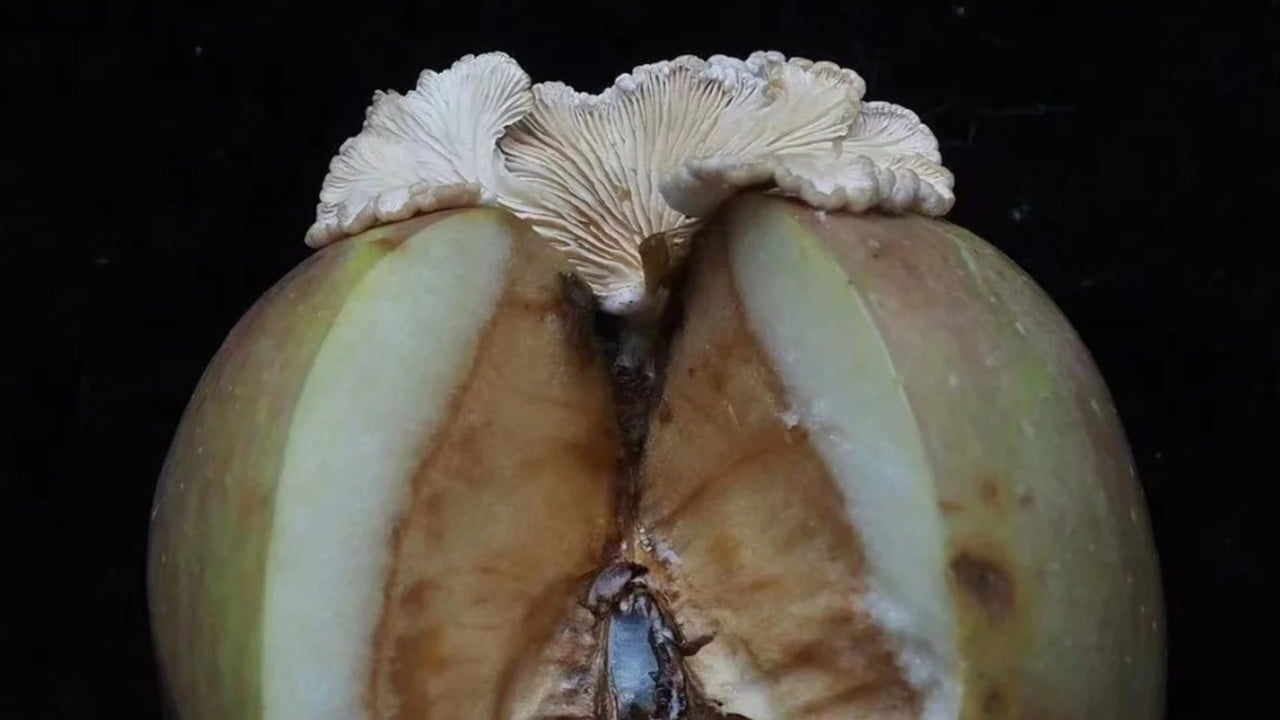A photo of an apple sprouting a mushroom-like growth has taken the Chinese internet by storm, leading researchers to investigate the unlikely pairing and what it could mean for fruit cultivation and breeding better strains of a fungus valued for its medicinal properties.
A social media user with the handle “Peirong” on the Chinese platform Xiaohongshu discovered the white fungal growth on an apple she had bought a month earlier. Her family convinced her to post a photo online, which soon attracted thousands of likes.
Among those who saw the unusual apple was Xu Rongju, a doctoral student at the Chinese Academy of Sciences’ Kunming Institute of Botany and Mae Fah Luang University in Thailand.
Xu identified the growth as Schizophyllum, also known as the splitgill mushroom – a type of fungus with fan-shaped caps.
Schizophyllum is found around the world and consumed as food and medicine in Asian countries. Although it is generally harmless, it can cause infections in human lungs if it is inhaled.
The fungus typically grows on things with a relatively neutral pH level, including rotten wood. However, apples are moderately acidic.
“The flesh of apples contains fruit acids, which generally do not favour the growth of fungi,” Xu said. However, Schizophyllum’s ability to resist acid might have been what allowed it to grow, according to the researcher.
Xu contacted Peirong to try to buy the apple, but the blogger said she would send the fruit to him and his fungus research group for free. The apple arrived at their lab in the city of Kunming in southwest China last week, according to media reports.
Xu observed the fungal fruiting body that had emerged from the apple, before cutting it open to look at the branching filaments, called hyphae, that extended into the apple.
The fungal species was confirmed through DNA sequencing, and fungus samples from different parts of the apple were isolated so they could be cultured in the lab to observe their growth and for use in future experiments.
Xu said his team believed that spores from the fungus might have fallen onto apples while the fruit was being transported or stored and then germinated into “wounds” on the apple stalks, later spreading into the apple flesh.
Zhejiang province, where Peirong lives and bought the apple, has had heavy rainfall and humidity this summer, which may have enabled the fungus to grow.

“Schizophyllum is a very important medicinal edible fungus with great economic and production value,” Xu said, adding that the research could be used in breeding a more adaptable or higher yield fungus.
Xu said the research could also help scientists understand Schizophyllum’s effect on apple cultivation.
“Typically, Schizophyllum prefers to grow on rotting wood. However, there have been research reports from other countries indicating that [it] can also cause apple wood rot disease,” Xu said.
In 2016, a research team from Tunisia reported that wood rot among apple trees several years earlier, which had affected the country’s biggest apple producing region, was caused by the fungus.
“Currently, there are no reports of the fungus causing large-scale disease outbreaks in apples. Therefore, the growth of white fungus on apples could provide some reference for future apple cultivation and production,” Xu said.
“We will compare it with Schizophyllum strains that we have sent into space. And we also want to taste whether it is apple-flavoured splitgill mushroom, which netizens are looking forward to.”
Xu often watches videos of mushrooms shared by other social media users and occasionally answers questions about types of fungi and whether they are edible.
“This is not the first time that netizens have helped researchers find materials,” Xu said, adding that he and his team “often receive mushrooms sent by enthusiastic netizens, and subsequent research has found that they are new species and have been successfully published”.


